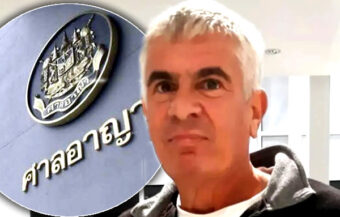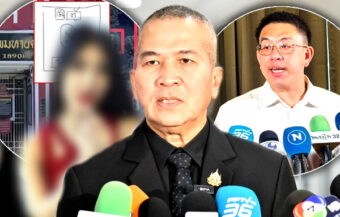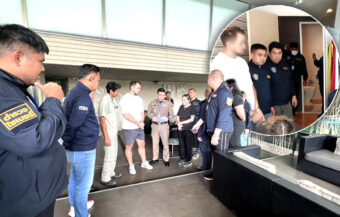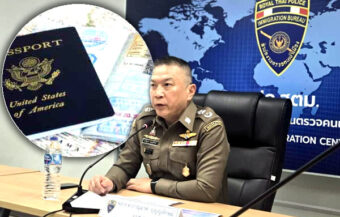Cambodia caught red-handed in lies. Shocking video shows soldiers planting deadly PMN-2 landmines along the Thai border, injuring soldiers and violating international law, as mobile phone footage shatters Phnom Penh’s denials and is likely to fuel Thailand’s diplomatic efforts to expose its adversary to the world.
Royal Navy personnel made a shocking discovery in the Phu Makhuea area along the Thai-Cambodian border: a smartphone abandoned by Cambodian forces. On it, video clips show Cambodian soldiers actively planting the controversial PMN-2 mines that have maimed and injured Thai soldiers since July. The footage is chillingly clear—soldiers handle the devices with precision, identical to the pristine mines displayed by the Royal Thai Army. This discovery shatters Cambodian propaganda and official denials, including statements from their military and demining agencies. Crucially, it adds serious weight to Thailand’s diplomatic briefings on the 1997 Ottawa Treaty, which strictly bans these deadly weapons.
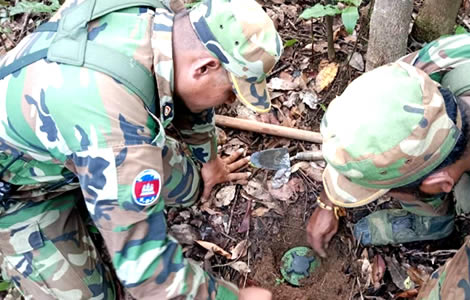
The Royal Thai Navy has uncovered alarming evidence of Cambodian soldiers secretly planting PMN-2 anti-personnel mines in the Phu Makhuea area. Meanwhile, reporters confirmed that the discovery was made during routine mine clearance operations by the 1st Mine Clearance Unit of the Royal Thai Navy Humanitarian Mine Action Unit (RTNMU).
Initially, Thai soldiers found a mobile phone abandoned at Company 132, Battalion 13, Nuea Mek Base. Upon charging and inspecting the device, officials discovered photos and video clips showing Cambodian soldiers holding PMN-2 mines. Moreover, the soldiers spoke in Khmer, providing detailed instructions on mine deployment.
Additionally, the clips appear to be instructional. They show soldiers demonstrating how to pull the safety pin, operate the mine, and carefully place it in dug holes. According to the Thai Navy, this evidence strongly contradicts Cambodia’s repeated denials of PMN-2 usage.
Thai Mine Action Centre confirms that new PMN-2 mines were deployed along the Thai-Cambodian border
In addition, the Thailand Mine Action Centre (TMAC) confirmed that the mines found along the Thai-Cambodian border were new. They had been prepared for deployment, with safety equipment removed. Furthermore, upon dismantling, TMAC specialists discovered intact firing pins, springs and internal components. These were all clearly unused, contradicting Cambodia’s claim that old mines were responsible for injuries.
Moreover, two types of mines were discovered in the Phu Makhuea area. The first type was an unused PMN-2 mine with the safety pin still intact, directly violating the Ottawa Convention. The second type consisted of dismantled mines, removed from the ground but in a ready-to-use condition. Some contained partially incomplete firing pins.
During dismantling operations, Thai infantry collected the mines carefully and handed them over to TMAC personnel. Then, the detonators and boosters were removed to minimise risks. According to officials, the operation adhered strictly to international safety standards.
Meanwhile, the Cambodia Mine Clearance and Assistance Agency (CMAA) strongly denied all allegations. They insisted the claims were politically motivated. In addition, CMAA added that Cambodia already has sufficient mines within its territory. They also emphasised that landmines are considered enemies, not weapons to harm civilians.
Recovered mobile timestamped phone clips show Cambodian soldiers digging and priming PMN-2 mines
Nevertheless, the mobile phone evidence appears compelling. The recovered clips clearly show Cambodian soldiers digging in preparation for mine placement. One clip lasts 1 minute and 8 seconds, and the other is 8 seconds long. Both contain timestamped information, further verifying the events occurred on-site.
Furthermore, distorted reports previously circulated in Cambodian media suggested that the Thai soldier injured by a landmine was affected by an old mine under Thai control. However, the new evidence challenges these claims. In fact, the mines were new, fully operational and carefully concealed by soldiers.
Moreover, the discovery highlights a troubling escalation along the border. The evidence shows that Cambodian soldiers not only possess PMN-2 mines but actively deployed them in Thai territory. Consequently, this is a significant breach of international law and a direct threat to border security.
Officials also found multiple mobile phones in the area, including Tecno Pova 6 and Pova 6 Pro 5G models, widely sold across Southeast Asia. Initially, the phones would not power on. After recharging, officers recovered six still images and two video clips, all showing soldiers handling PMN-2 mines.
Recovered video clips offer detailed records of Cambodian soldiers demonstrating safe handling of PMN-2 mines
Additionally, reporters emphasised that the recovered clips provide a detailed visual record of mine deployment techniques. Cambodian soldiers appear to instruct colleagues on proper handling procedures. This includes pulling the pin, understanding firing mechanisms, and planting the mines safely in dug holes.
The Royal Thai Army strongly condemned fake news spreading in the media about Thai soldiers removing barbed wire and flags. These claims were attributed to Cambodian sources attempting to distort facts. Meanwhile, the Navy evidence provides a concrete counter-narrative.
Earlier, Minister of Foreign Affairs Maris Sangiampongsa led a diplomatic delegation to the Phu Makhuea area. They observed the landmines firsthand and briefed Ottawa partners on the security risks. The delegation described the scene as highly organised, with clear evidence of premeditated deployment by Cambodian soldiers.
Furthermore, TMAC officials explained that dismantled mines contained all new internal components. No reused parts were observed, confirming the mines were prepared recently for operational use. Such evidence undermines claims that the mines were leftovers from old conflicts.
Thai soldiers suffer injuries from deployed mines, as evidence shows clear violation of Ottawa Treaty
The implications are serious. Thai soldiers have already suffered injuries from these mines, including a number who lost their legs or feet. Investigators suggest that other deployed mines may still pose a threat in undiscovered locations.
Additionally, international law prohibits the use and stockpiling of anti-personnel mines like the PMN-2. Cambodia’s actions, if verified, would represent a blatant violation of the 1997 Ottawa Treaty. Experts warn that further monitoring and investigation are critical to prevent additional casualties.
The evidence recovered from the mobile phones is considered highly reliable. It contains metadata, timestamps and detailed video content showing soldiers actively planting mines. Therefore, officials argue that this material is crucial for documenting violations and pursuing accountability.
Meanwhile, CMAA continues to deny wrongdoing, calling Thai claims baseless. They emphasised that Cambodia’s focus remains on demining and protecting civilians. However, officials caution that denial alone does not remove the mounting evidence showing new mine deployment in Thai territory.
Security analysts warn deliberate mine deployment creates military threat and humanitarian crisis on border
Moreover, security analysts say this incident could escalate tensions along the border. They stress that deliberate mine deployment represents not only a military threat but a humanitarian crisis. Anti-personnel mines indiscriminately endanger civilians and military personnel alike.
According to Royal Thai Navy reports, the soldiers who discovered the phones acted according to protocol. They secured the devices, examined the content and passed them to higher authorities for further investigation. This ensures the evidence can be legally and safely verified.
Additionally, the discovery reinforces the importance of ongoing mine clearance operations in border regions. Thailand has invested in Humanitarian Mine Action Units precisely to detect, dismantle and safely dispose of landmines. Without these operations, civilians and soldiers would face much greater danger.
Experts also point out that PMN-2 mines are highly lethal. Once armed, they can cause catastrophic injury. Consequently, identifying deployment sites quickly is critical to saving lives. Thai authorities are working to locate any remaining mines in the Phu Makhuea area.
Diplomatic pressure ramps up as Thailand urges Cambodia to dismantle stockpiles and come clean
Meanwhile, the diplomatic corps in Bangkok is closely monitoring the situation. Thailand continues to urge Cambodia to comply with international law, dismantle stockpiles and provide transparency regarding mine usage. Failure to do so may increase regional tensions.
Certainly, the Royal Thai Navy’s discovery of mobile phones, images and videos showing Cambodian soldiers planting PMN-2 mines is highly significant. It provides the first visual evidence of deliberate, modern mine deployment in the Phu Makhuea area.
Furthermore, this evidence contradicts previous Cambodian claims denying the presence or use of such mines. The Royal Thai Army, TMAC, and humanitarian agencies now have a clear mandate to pursue further investigation and ensure border safety.
Soldier loses foot and 2 others injured by Cambodian PMN-2 landmine in Sisaket while on border patrol
Cambodia is using lethal Russian PMN2 landmines to subvert the Thai military’s composure on the border
With the growing evidence, authorities stress vigilance, transparency and accountability. Mine clearance operations continue and officials emphasise that both soldiers and civilians remain at risk until the area is fully secured.
The case also raises pressing questions about international compliance, human rights and the ongoing threat posed by anti-personnel mines. As more information emerges, observers expect heightened diplomatic scrutiny and potential international investigations.
In short, the Phu Makhuea discovery is a stark reminder of the dangers of anti-personnel mines and the importance of vigilance along international borders. Undoubtedly, the evidence from Cambodian soldiers’ phones fundamentally alters the perception of Cambodia and its ongoing propaganda. It has damaged its reputation in Southeast Asia and within the international community, exposing Phnom Penh as a source of bare-faced lies.
Join the Thai News forum, follow Thai Examiner on Facebook here
Receive all our stories as they come out on Telegram here
Follow Thai Examiner here
Further reading:
Charged situation – Defence chiefs from Thailand and Cambodia meet in Kuala Lumpur. ASEAN damaged
Fear on Eastern border under Martial law. Cambodian Bond nabbed on ฿162 a day from Phnom Penh regime
Cabinet meets after Cambodian ceasefire. Acting PM Phumtham spoke later with Trump for 30 minutes
Acting PM travels to Kuala Lumpur for ceasefire talks. Cambodia’s PM Hun Manet to attend amid PR war
Hot War rages on the Thai-Cambodian border following Cambodian troops offensive in Chong Bok area

